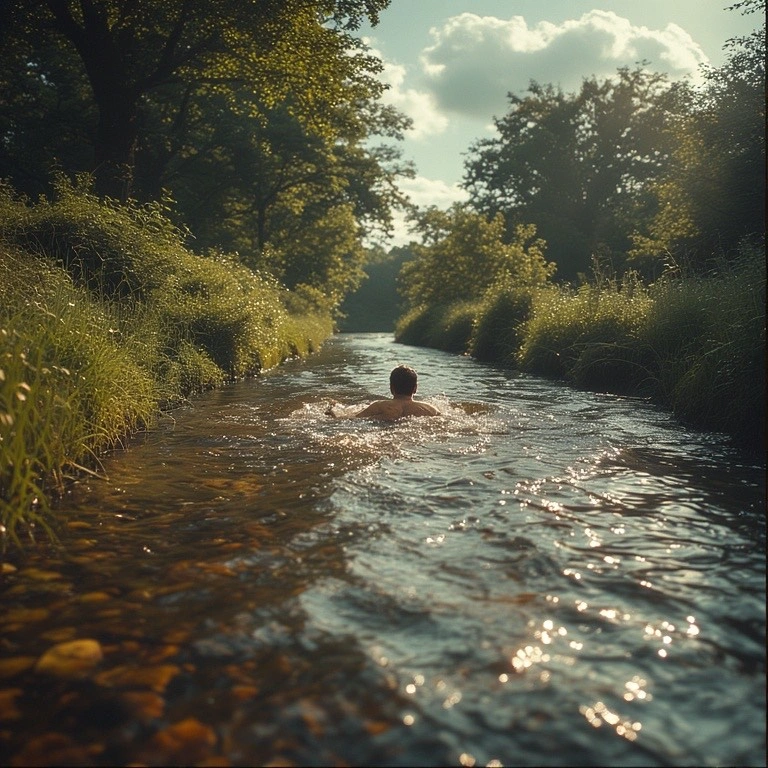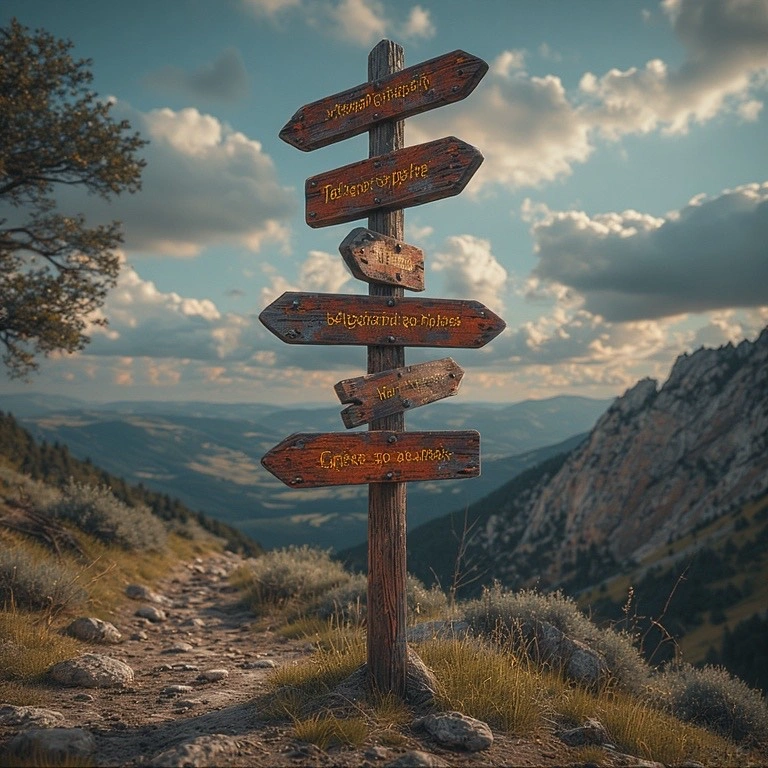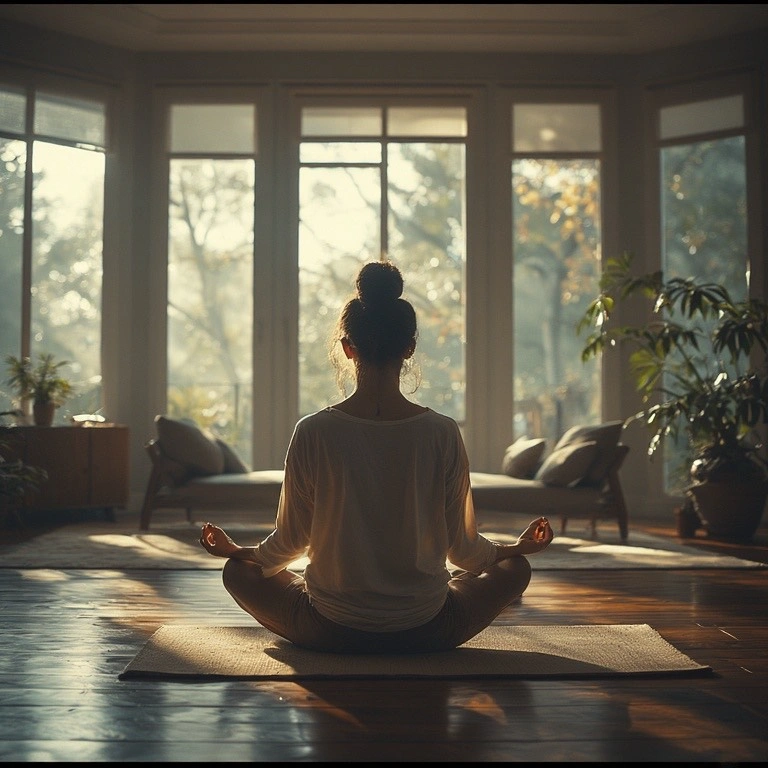Natural flow is a sensation we will have all undoubtedly felt at one point or another in our lives. Knowing how to identify natural flow and aligning yourself with the sensation can have tremendous and positive outcomes.
If you haven’t already, you should check out the introduction to flow vs. resistance to get an overview of how the framework works to improve your life and what each concept means.
In this article I am going to take a deep dive into how to identify natural flow and how to harness that flow state to improve your life – in every area.
An Introduction to the Concept of Flow
In the framework (or philosophy or whatever you want to call it), flow is the state of natural alignment and is the opposite of resistance.
Flow is easy to conceptualise and easy to identify, because it feels so natural. It is however hard to achieve and requires practice in your life to get into the desired ‘flow states’.
To paint a picture, natural flow is exactly like water in a river, running from the source to the ocean. Water flows always and even if it encounters obstacles (resistances) it effortlessly finds ways to navigate around them.

What Natural Flow Actually Feels Like
Natural flow feels like quiet self-assured control. It can have many other sensations such as a sense of effortless achievement and bliss.
When you operate in a state of flow, the world seems to be collaborating with you to get to the outcomes you desire.
A great everyday analogy is driving through a town, and all the traffic lights are green, making the journey one smooth uninterrupted transition from a to b – in spite of the other traffic and busy town environment outside.
The Physical Sensations
Physically, flow is calmness even when you would otherwise be stressed out by a situation. There is no anxiety, depression or negative aspect to flow.
It is also (perhaps counterintuitively) decisive. When in a flow state you can make the best decisions to navigate problems without realising how the solution came to you. It just works.
There are myriad examples of people operating in flow states across all aspects of life. Commonly, successful sports stars like racing drivers will describe outside influences diminishing and becoming ‘one with the car’ or ‘in the zone’.
Physically a natural flow state is empowering, the ability to step out into the world with confidence, knowing you’re equipped to tackle whatever challenges come your way – not through forcing through them, but by navigating them optimally.
The Emotional Signatures
Emotionally there are many positive feelings you might experience when in a flow state, but most commonly you will feel peaceful.
Others might look in on your situation and wonder how you can be so collected especially if there is chaos swirling around you.
But when you are in a flow state, chaos is not a problem, you will be able to dance around or overcome problems with ease and clarity.
Ultimately, being in natural flow feels really good. It feels like you are doing something great for your mind, body and spirit. It satiates you. You’re never longing for something or hungry for something in a flow state.

Recognising Natural Flow in Our Daily Lives
In order to build a more consistent flow state, it is important to start small and first recognise the areas in our daily lives where flow appears – or where flow is absent so we can then progress towards flowing through those situations.
In Our Morning Routines
To give you an idea of what I mean, let’s look at a few scenarios in everyday life.
Flow Mornings – Occasionally, perhaps even rarely, everything seems to flow in the morning. We wake up at the right time, before our alarm is set to go off. We head down to breakfast, enjoy our food and realise we are still ahead of schedule. If you commute, you arrive on time and the journey seems a breeze, you may even get a much coveted seat on the train.
Resistance Mornings – Resistance mornings are far more common; people find the alarm doesn’t go off or they have accidentally turned it off and gone back to sleep. They rush to get out the door in the morning, sometimes having to skip breakfast and when they arrive at the train station – find they have missed the train, or it is delayed. How often do we hear the phrase ‘it’s been one of those mornings,’ from colleagues and friends? This is a typical resistance morning, and most people experience it on an almost daily basis.
During Work
When at work or being productive, flow makes the day fly by, and resistance makes it drag like a bitch.
Flow During Productivity – Flow at work or during productivity is akin to mastery over your output. Ideas come naturally, solutions work themselves out and your work product is of a high standard without even trying. Time flies in flow.
Resistance During Productivity – Resistance during productivity looks like procrastination, being stuck on tasks, inability to focus and the work output is poor to ‘good enough.’ You can easily spot a resistance day when you are watching the clock and just wishing the day would end.
Social Interactions
Another easy area to spot natural flow is in our social interactions.
Flow with People – When we are in a flow state, conversations become easy – even the conversations we would ordinarily expect to be difficult. People are receptive to our ideas, keen to listen and engage and the experience is pleasant and productive.
Resistance with People – If we have resistance in social interactions (extremely common), our conversations are stilted. It can seem like the other person is not listening and instead waiting for their turn to speak. If the resistance level grows in these situations, it can be deeply unpleasant with anxiety spiking and negative outcomes such as arguments and disagreements.

The Art of Decision Making with Natural Flow
To summarise where we are so far as I have covered a lot, natural flow is a state we can all experience and develop for better outcomes in our lives. Critical to this is decision making.
Common wisdom schools will talk about natural flow as a passive state. This is completely untrue. Natural flow is an engaged and pro-active optimal state. You don’t sit back and do nothing and hope for the best under this framework.
In fact, being in natural flow can sometimes even be a very ‘busy’ state where optimal decision pathways are opening up and providing you plenty of opportunities for progression. The key is understanding what an optimal decision pathway is – and this is why flow states are hard to achieve and harder to maintain.
Green Light Decisions (Optimal Flow)
When you are in a flow state, an optimal decision will come naturally. This means it will feel unforced and that you can make the decision and take the action without feeling like it is a burden. Essentially the solution emerges in your mind with clarity, and you can then proceed without concern.
Red Light Decisions (Forcing)
Any solution that feels intuitively forced or like you’re manipulating the situation to get a desired outcome is a resistance building decision. This doesn’t need to be decisions made with bad intentions, the road to hell is paved with good intentions. Even if you think you are doing the best possible thing or seeking the best possible outcome, if you’re forcing the decision or manipulating the situation it is a resistance building decision.
Amber Light Decisions (Wait and Consolidate)
Sometimes, your life may throw extremely complex challenges your way. You may have mastered entering flow states but still feel daunted or overwhelmed by a particular set of circumstances. In these instances, you may find it difficult to discern if a decision has come naturally or if you have artificially forced a decision into the mix.
In these cases, it is best to take a step back, trust the process and sit with the decision for a while. If it is truly natural, the decision will get easier and easier to make. Whereas if it is a resistance decision, you will feel yourself forcing yourself into making it.

Common Everyday Resistance Traps
Flow states can be achieved and stabilised when you understand what you are doing and how to do it. However, when you are in a flow state it can be easy to talk yourself out of it. Here are some very common ways people leave a natural flow state without realising.
“But I Should…” vs Natural Flow
As discussed above, decision making and taking optimal action is critical to benefiting from natural flow. The pesky ‘but I should…’ objection that our brain kicks up is resistance building because when you ‘should’ do something, you’re essentially boxing yourself into a decision and forcing.
Natural flow may well direct you towards what you initially thought you should do – but oftentimes, natural flow decisions will not follow expected routes, the outcomes however are always more beneficial than if you forced yourself into a decision because you felt obligated to take it.
“This is Too Good to Be True”
When you are navigating through life using natural flow, the world around you seems less volatile and outcomes naturally emerge in a positive and abundant way. It can sometimes feel ‘spooky’ or ‘magical’ which has a jarring otherworldly effect on the brain.
If you are conditioned to struggle in life, when all of a sudden you are able to utilise natural flow, it seems ‘miraculous.’ The too good to be true objection then causes people to reject natural flow because they expect trouble around the corner.
Don’t fall into this trap, the too good to be true is just conditioning towards resistance patterns.

Developing Natural Flow Recognition Skills
Developing natural flow is an incremental process for most people. This is because our daily lives are chock full of resistance patterns – many of which are very difficult to discern – don’t worry, future blog posts will delve into resistance patterns, how to spot them and how to remove them from your life.
For the most part, you will be able to develop natural flow skills that compound over time. Before long, with the right degree of commitment, you will even be able to sustain natural flow indefinitely. A concept I call flow mastery.
Skills to Develop Natural Flow
There are various small practices you can immediately do to develop more alignment to flow state.
Daily Awareness Practices
These are straightforward practices that are easily incorporated into your day.
The key with developing natural flow is not to force yourself into doing these things. Instead, when it feels natural to do them, then incorporate them. You don’t need to do any activity for a specific time – only as long as you feel is necessary or you feel comfortable.
Lastly, it is not good to develop routine around natural flow activities, ritualistic flow practices begin to create a structured resistance pattern over time. If one day you really can’t be arsed to do an activity, then trust that as optimal flow and don’t force yourself to.
Grounding Activities
Conscientious breathing is the absolute best grounding activity. Being aware of your inhalation and exhalation grounds you by providing your body with a natural rhythm and supplying it with oxygen. It is no secret that breathing techniques have calming effects, and this practice has been utilised by people for millennia.
Deep breathing is all you really need to do. Just being aware of your breath. Some people prefer fixed patterns such as box breathing – however, this isn’t optimal because it is creating a rigid structure (resistance).
Instead, just relax into your deep breathing, do it naturally and when you feel you have grounded yourself in a chaotic situation, move on. You really don’t need to do anything more than just relax into whatever breathing pattern feels best for you.
Meditative Activities
Meditation is excellent when done correctly.
Personally, I like to set aside a little time each day to sit in stillness and repeat the mantra ‘I am.’ Focusing on the gift of sovereignty and the ability to flow with my environment. I don’t do it at a particular time each day and I only do it for as long as I feel comfortable. And some days, I don’t need to do it at all.
Mantras are great for self-grounding, focusing specifically on your body and mind.
The key to meditation under this framework is not to try and force thoughtlessness or force a particular way of feeling. I like to think of it as just accepting whatever stillness nature presents me at that time.
I will go into more detail about meditation as there are many pitfalls to avoid, but on the whole, following the guidance above really helps establish natural flow alignment.

Gratitude – Identify Natural Flow
If life is difficult, it can be extremely difficult to feel grateful. I completely understand that gratitude and the common human lived experience seem antithetical to each other.
Personally, I like to just think of the things I am grateful for either over the course of the day just gone or life in general, before I fall asleep at night.
Others might wish to create a gratitude journal, documenting little moments of success and gratitude as and when they occur.
The more aligned with natural flow you become the more gratefulness will feel natural because positive outcomes and abundance follow flow states. In short you will have more to be thankful for as you develop natural flow.
Time in Nature – Identify Natural Flow
Many people live hectic, busy urban lives. Even as I sit and type out this blog article, I am in a busy and noisy town.
The environment we find ourselves in is often out of our control, but most people are never more than twenty minutes away from an unspoilt natural environment.
Walks in forests, along rivers or evenings spent looking up at the stars are perfect experiences that enhance flow states. In fact, any time with anything natural has a net positive impact on you reaching more flow.
Weekly Reflection – Identify Natural Flow
As you build your skills and develop more harmony with the natural world around you, it is brilliant to track each week what went well, where you want to do more and where you have identified resistances.
This doesn’t need to be a structured reflection, it can be as simple as finding a few minutes somewhere quiet and just reflecting on the past week.
If you find yourself more inclined to document methodically how you are doing using the framework then absolutely go ahead and do that.
Remember, flow is whatever feels natural to you, and we are all different and sovereign beings.
Ultimately, when reflecting, I find myself understanding that when I was operating from a flow state, it felt good. Not surface level good, it genuinely felt fulfilling and wholesome. In the same way that having an apple feels both satisfying and ‘good for you.’ Flow becomes a self-rewarding system.

When Saying No IS Natural Flow
Natural flow is not about ‘going with the flow,’ and it is not about sacrificing authenticity or sovereignty.
In fact, authenticity, truth and sovereignty are fundamental to natural flow alignment.
This means you don’t have to feel forced to go along with anything you’re uncomfortable with. You don’t have to say yes to every opportunity that seems to present itself.
Trust your gut is a much more appropriate phrase for natural flow in this framework and if it feels right to say no – then say no.
Never sacrifice your integrity because you feel compelled to for whatever reason. This is exactly the kind of resistance pattern you want to be avoiding.
Building a Natural Flow Mindset for Life
Knowing how to identify natural flow states allows you to really experience life as intended – moment to moment.
Because resistance patterns in our daily lives are so prolific, it will take skill development to optimise across all areas of your life. But the beauty of it is that you don’t need to force change. You will be able to incrementally build flow states and flow into a masterful flow mindset.

Trust the Natural Flow
Finally, natural processes often appear mysterious, especially in a world plagued by dogmatic and wrongheaded materialism. As humans we are conditioned by everyone in everyway to accept the materialist doctrine and it can sometimes be really difficult to bridge that void in our minds.
What I would say is, the framework I am presenting works perfectly for reasons I will not yet reveal. But rest-assured, understanding you can trust the natural process and that positive outcomes follow from that trust will really set you up for tremendous success.
At the moment I encourage you to take a faith based approach and be as sceptical as you like. Try maybe just one of the steps outlined and see for yourself what results follow. The more you trust natural flow, the more exponentially the rewards grow, but if you want to approach it with caution, then please by all means do – it is your life, your choice and ultimately your sovereignty and authenticity that is critical in progressing on this journey.




